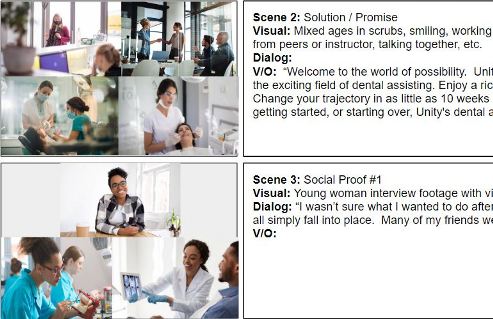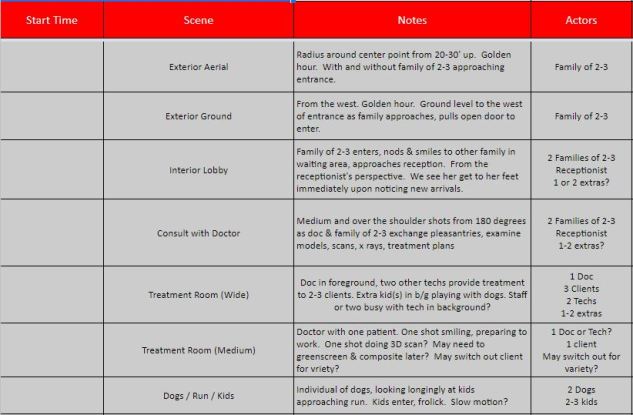Looking for a video pre-production success formula? Was your last commercial video project a nightmare? Did you end up reshooting, making way too many revisions, going over budget, and when it was over, while it looked pretty good, you weren’t actually sure if it was even effective? If you’ve ever made a video to market your company, you’ve probably experienced one or all of these issues. Today, we’ll walk you through a simple, 6-step video pre-production success formula that will save you thousands, and make production a breeze! By following a good video pre-production process, you ensure that your video is going to achieve its intended purpose, whether that be branding, generating sales, exposure, or education.
Step 1: Determine the Purpose of Your Video
Ask yourself: why do you want to make a video in the first place? What is the point?
You might want to increase sales, build trust with clients, define your brand, educate customers on a product or service, or showcase a live event.
You cannot skip this part of the pre production process. You would be surprised how much trouble you can prevent down the road by getting clarify on the purpose of your video. If you have a very clear goal for what you want your video to achieve, you’ll have a much better chance of success. When you examine your objective clearly, you might realize that you don’t need to produce a video at all; some other form of marketing might be a better investment for your business!
Pro Tip:
Once you decide what you want your video to accomplish, you’ll also need a way to track how well your video is doing. Depending on your type of video, that could mean views, comments, or clicks to your website. Make sure you clearly define what a successful video campaign looks like in advance.
Step 2: Determine Your Target Audience
 Next, you need to find out who your ideal target audience is (if you haven’t already).
Next, you need to find out who your ideal target audience is (if you haven’t already).
Familiarizing yourself with your ideal viewer will guide your decisions all along the pre-production process so that your video will better resonate with their needs and wants.
Imagine the ideal person you would want to watch your video, and the action you want them to take; this could be a hypothetical employee, or the perfect client you would love to have. Write down some key characteristics about them.
1. What is their income level?
2. Are they self employed?
3. How much free time do they have?
4. Are they married?
5. Do they have children?
6. What are their interests and hobbies?
7. What are their values?
8. What problems are they facing?
9. What are their purchasing habits?
When writing about your ideal customer, remember: you are trying to market toward the clients you want, not the clients you already have. Video pre-production for success means you have a clear target, and you know when you hit it.
Step 3: Allocating a Budget
The next step of the video pre-production success formula is to allocate a budget for your video project.
A clearly defined budget will ensure you don’t get in over your head with extra expenditures and charges associated with production. A hard budget cap will prevent things from getting out of hand.
Don’t be afraid to share your budget cap with your video production company. I know this feels like a trap, but if they know what your limits are, they can best advise how to meet your needs, within your budget. You should have enough trust in your production company to know that they’ll not run right up to your cap on every project. They should present you with options to meet your goals, at different tiers within your budget spectrum.
When trying to stay within your budget, remember that different factors can affect how much your video is going to cost. If your budget is limited, you may need to revise your expectations. For example, live actors will cost more than voice over narration, and shooting new footage will cost more than using existing media or stock footage. Animations will cost significantly more than simple on-screen text, and licensing music is more expensive than the free stuff.
Don’t worry if your budget is low! It’s absolutely possible to make a great video that meets your marketing and sales goals without spending too much. As long as you understand your audience and plan your message carefully, you can create a great video with a small budget.
Step 4: Write Your Script
 Your script is the key to getting the perfect message across to your target audience. Your script will guide your messaging, whether that’s through text, voice over, or narration from a live actor.
Your script is the key to getting the perfect message across to your target audience. Your script will guide your messaging, whether that’s through text, voice over, or narration from a live actor.
Your script is the core of the message you want to send. It forms the backbone of your video, and the rest of your planning efforts will rely heavily on having a well written script. If you don’t take the time to perfect your script beforehand, you’ll need to go back and change it later, which can become expensive very quickly.
Once you start writing your script, you can treat it like any other writing project. Start with an outline of all the information you want to cover, then create a rough draft. Once you have a rough draft complete, narrow it down until you’ve made all your points clearly, and succinctly. Now ask someone to read it out loud to you, so you can hear how it sounds, and then make revisions as needed. Take as much time as you need to get the script perfect before moving on.
Pro Tip:
You should use a timer to see how long it takes to read out loud. If you want your video to be short, but it takes a long time to read, you’ll need to trim out more content until it fits into your time frame.
Step 5: Create Your Storyboard
The next step of the video pre-production success formula is to craft a “storyboard.” Your storyboard is a visual representation of what each shot is going to look like and what parts of the script will accompany it.
Your storyboard should have a panel to show what each shot will look like, and a space for the part of your script that will accompany it. It should look something like this:
A detailed storyboard with pictures/drawings and script references will help you visualize the shots and communicate what you want to your camera operator. A storyboard is the most crucial component to saving on filming costs and needless re-shoots.
You can fill out the panels with drawings, photos, or screenshots that represent each shot you want to see. In a space next to the panel, add the part of the script that will accompany that scene. Don’t forget to add any special details or considerations for how you want to shot to look. By the end of it you should have your whole video planned out on the storyboard, looking something like a comic book. This will be an essential tool for when it comes time to film your shots.
Step 6: Create Your Shot List
The shot list is your complete schedule for the day of filming. That’s when you and all your talent will get together and gather all the media you need.
A completed shot list will work as a schedule for you and your talent. It will preventing miscommunication, and will keep everyone on the same page for the whole shoot.
Your shot list should include these categories:
1. The shot
2. The location where the shot takes place
3. The time of shooting
4. Necessary crew
5. Necessary actors
6. Detailed description of the shot
Run your shot list by anyone who needs to approve it. Once it’s O.K., send a copy to everyone involved, and send reminders ahead of time that the shoot is coming up!
Make The Video Pre-Production Success Formula Work For You!
If you’ll follow this simple video pre-production success formula, your video will be on time, on budget, and in line with your goals. Comments, questions, or concerns? Need help with your video? Visit our video production page! Happy video-making!

